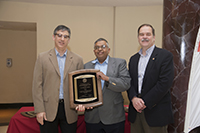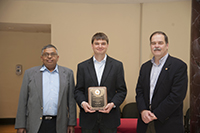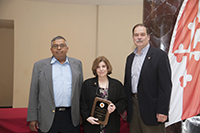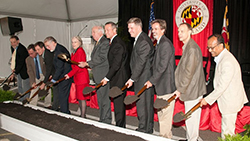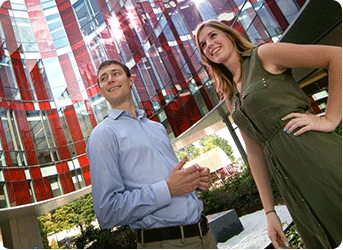Professors Drake, Gates named Distinguished University Professors
- Details
- Category: Department News
- Published: Monday, May 05 2014 10:17
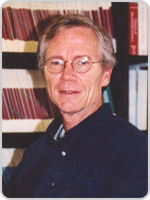
Two members of the Department of Physics have been named Distinguished University Professors. This designation is the campus’ highest academic honor, reserved for those whose scholarly achievements “have brought distinction to the University of Maryland.”
Professor James F. Drake, a plasma theorist, received his PhD from UCLA and had research appointments there before joining UMD as a postdoc in 1978. He became a full professor in 1990, jointly with the Institute for Physical Sciences and Technology. He is a Fellow of the American Physical Society and the American Geophysical Union. In 2010, he received the very prestigious James Clerk Maxwell Prize for Plasma Physics from the American Physical Society. He is co-director of the Joint Space-Science Institute, a research partnership between the Astronomy and Physics departments of the University of Maryland (UMD) and NASA Goddard Space Flight Center.
Professor Drake is a well-reviewed teacher and excellent overall communicator, having received the Popular Writing Award of the Solar Physics Division of the American Astronomical Society. With colleagues from NASA, he helped create a video highlighting a 2011 paper that described the edge of the solar system as an effervescent wonder of magnetic bubbles nearly 100 million miles wide: https://www.youtube.com/watch?v=5HbJiY1wATQ
Professor Drake continues to investigate the structure of the heliopause, the boundary between the environment of the sun and the local interstellar medium. In addition, he is currently working with colleagues at the University of California, Berkeley, on magnetic energy's production of intensely energetic particles that are both scientifically intriguing and dangerous to manned space missions and Earth-orbiting satellites.
Sylvester James “Jim” Gates, Jr. received his PhD from the Massachusetts Institute of Technology in 1977 and was an assistant professor of mathematics there before joining the UMD faculty in 1984. He was recently elected to the National Academy of Sciences. At the April 2014 induction ceremony, NAS President Ralph Cicerone cited Gates' groundbreaking work at the interface of information theory and superstring theory, and for efforts to engage the public, as Gates signed the membership book, becoming the first African-American physicist included in the 150 year-long NAS history.
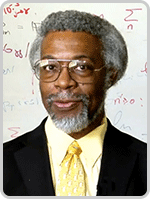
Professor Gates is the John S. Toll Professor of Physics and Director of the Center for String and Particle Theory at the University of Maryland. He is a UMD Distinguished Scholar-Teacher, a University System of Maryland Regents Professor, a member of the American Academy of Arts and Sciences and the Harvard Foundation’s 2014 Scientist of the Year. He serves on the President's Council of Advisors on Science and Technology (PCAST) and the Maryland State Board of Education. He chaired the Department of Physics at Howard University from 1991-93, and holds honorary degrees/appointments from the University of Western Australia, Stellenbosch Institute for Advanced Studies, Loyola University of Chicago, NYU Polytechnic Institute and Georgetown University.
He received the National Medal of Science at The White House in 2013.
He has been featured frequently on the PBS television program NOVA as an expert on physics, and has completed a DVD of 24 half-hour lectures that make the complexities of theoretical physics understandable to laypeople. In 2013, Villanova University awarded him the Mendel Medal, which honors scientists whose lives and work demonstrate that there is no intrinsic conflict between science and religion.
